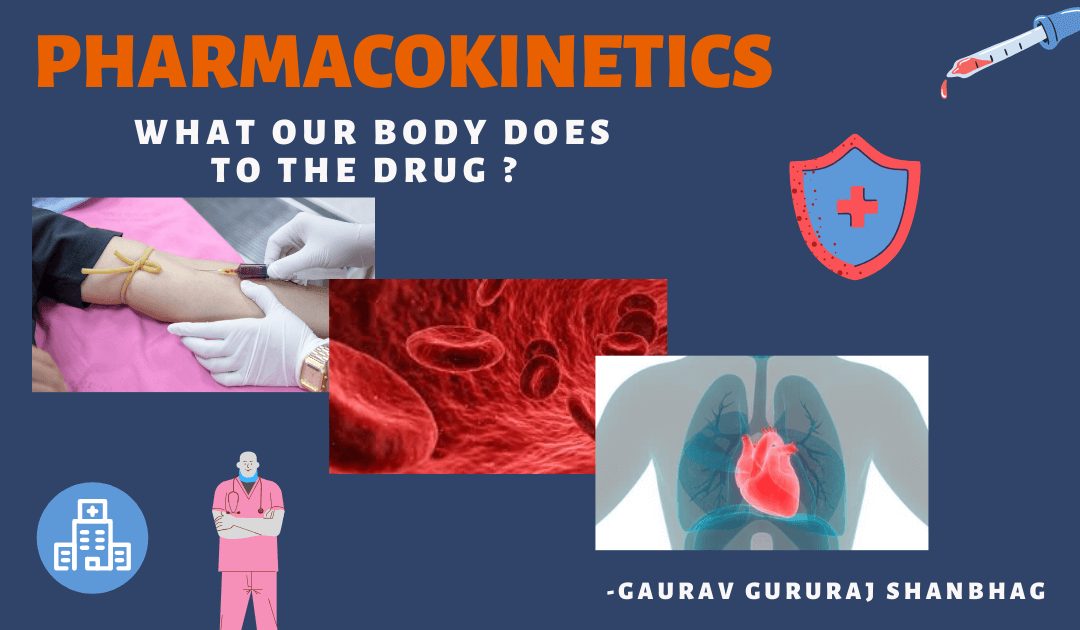As discussed earlier in my previous blogs about Introduction to Pharmacology, Pharmacokinetics is what body does to the drug! Pharmacokinetics is a part of pharmacology where when drug is administered, drug moves from site of application to site of action, the whole processes is pharmacokinetics.
Pharmacokinetics is derived from Greek words Pharmacon means drug and kinesis means movement. It implies movement of drug from site of administration to it site of action, many in between processes are carried out like ADME (Absorption, distribution, metabolism, and Excretion).
What you get below?
- Biological Membrane
- Types of Transport mechanism
- Passive diffusion and filtration
- Specialized transport
- Difference between simple diffusion and facilitated diffusion
- Conclusion
- Frequently Asked Questions (FAQs)
Biological membrane
For describing biological membrane, most preferred model is Fluid Mosaic Model.
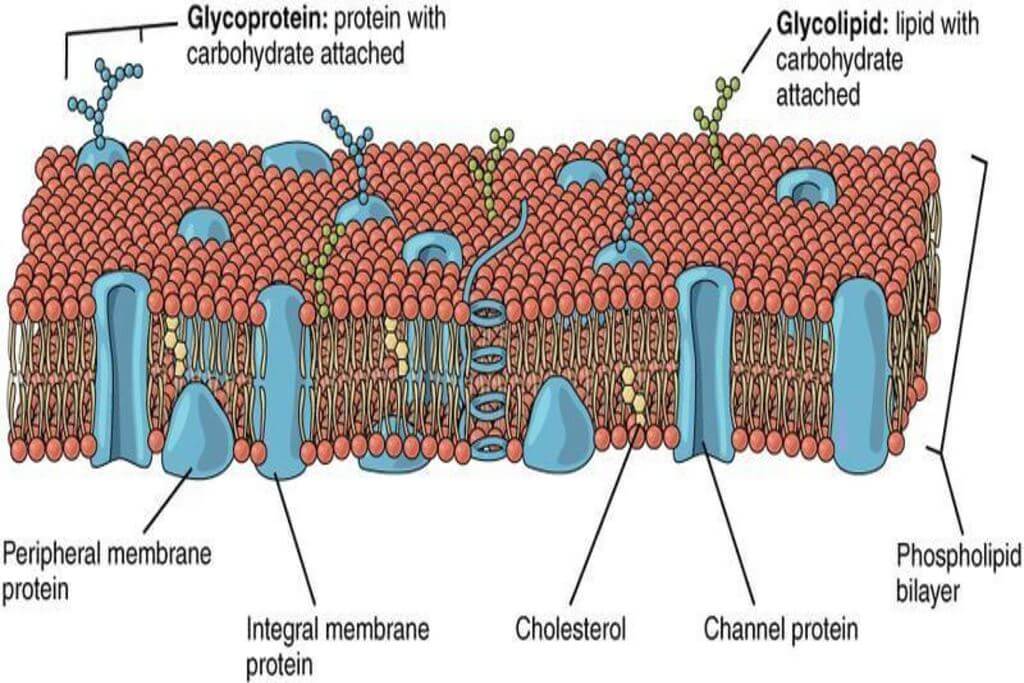
The biological membrane or plasma membrane is flexible membrane which acts as line of control for any foreign matter or material. It surrounds the cell and contains cytoplasm.
This plasma membrane or biological membrane is lipoidal in nature because its composition is Lipids in large amount and some proteins, cholesterol and many other chemical components.
The basic structural framework is of biological membrane is lipid bilayer. About 75% of the membrane lipids are phospholipids– lipids which contain phosphorus, about 20% is cholesterol and various glycolipids are about 5%.
Proteins are freely moving or are freely floating through the membrane.
The intrinsic proteins extend throughout the membrane and extrinsic proteins are present at the ends or in middle but do not extent throughout the membrane.
The biological membrane is Amphipathic that is it contains both polar and non polar group. Polar group is hydrophilic and non-polar group is lipophilic.
Biological membrane is an integral part of Pharmacokinetics.
Types of Transport mechanism
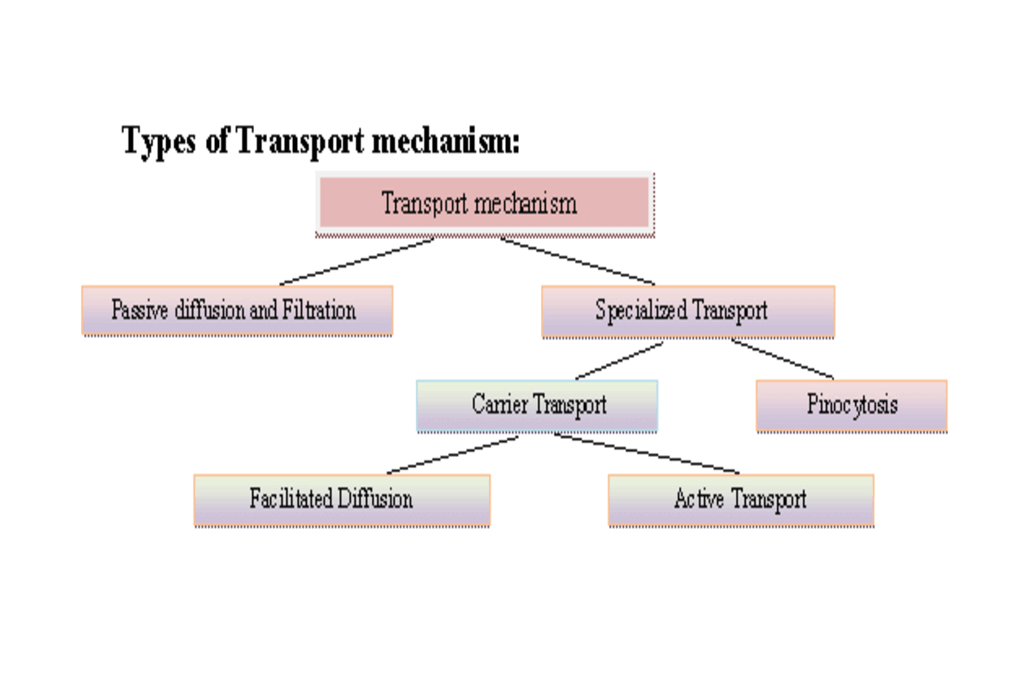
Transport mechanism are classified into two main categories, they are Passive diffusion and filtration and another is Specialized transport.
Specialized transport are further divided into two classes , they are Career transport and Pinocytosis.
Career transport are further divided into two sub-classes, they are Facilitated Diffusion and Active transport.
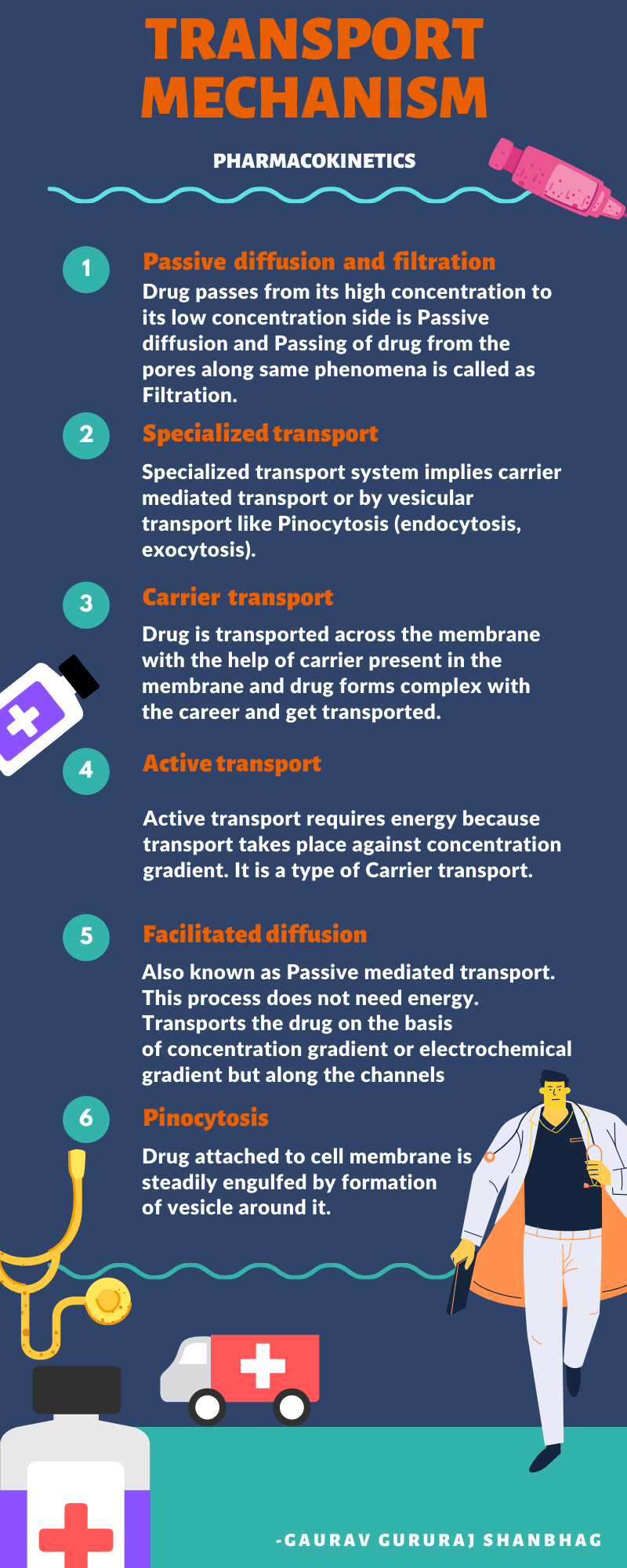
Passive Diffusion
Most of the drugs follow this mechanism of transport.
The drug diffuses across the biological membrane along its concentration gradient that means the drug passes from its high concentration to its low concentration side.
Here membrane does not play any active role in the drug transport. As the biological membrane is lipoidal in nature, the lipid soluble drugs diffuse quickly along its concentration gradient; the rate of transport will be proportional to the lipid: water partition coefficient of the drug.

Most importantly, no energy requirement is needed. More is concentration difference between inner and outer surface, more fast it the diffusion.
As it is not necessary that every drug is lipid soluble, so our body has developed many advanced transport systems and they are highly specialized.
Factor affecting drug transport by passive diffusion in Pharmacokinetics will be: Ionization status of the drug or lipid solubility and Concentration gradient.
- Drugs in unionized from are lipid soluble and their diffusion is fast.
- Drugs in ionized from are water soluble and their diffusion is slow.
- Acidic drugs are transported better in acidic medium and basic drugs are transported better in basic medium.
- Amount of drug determines the concentration gradient.
Filtration:
Filtration is the process of drug transport where the drug is passes from pores present in membrane which are aqueous in nature.
The filtration can be accelerated by using hydrostatic pressure and osmotic pressure gradient.
Example of which is drugs across most Capillaries including glomeruli.
Lipid soluble drugs also cross biological membrane by filtration, but it is size dependent. If the molecular size is small the drugs cross the membrane but if its large then it will not cross.
Majority of cells (intestinal mucosa, RBC, etc.) have very small pores (4 A˚) and drugs with MW > 100 are not able to penetrate. However, capillaries (except those in brain) have large paracellular spaces (40 A˚) and most drugs (even albumin) can filter through these spaces.
As ultimately, the crossing of drug from blood capillaries is dependent on the blood flow through the site of application of drug.
It does not require energy.
Size of the pore is ultimate limitation. Filtration mainly takes place through glomerulus.
Specialized transport:
Specialized transport system in Pharmacokinetics implies carrier mediated transport or by vesicular transport like Pinocytosis (endocytosis, exocytosis).
A) Active transport
B) Facilitated diffusion
2. Pinocytosis
1. Carrier transport:
Carrier transport implies that the drug is transported across the membrane with the help of carrier present in the membrane and with the help of complex which transports the drug from one side to other.
All cell membrane has this type of transport mechanism which transports important ions, nutrients, metabolites, transmitters and many other things across the membrane with the help of carrier proteins present in the biological membrane.
When the carrier forms a complex with substrate (drug) it transports the substrate across the membrane and as it reaches the other side the carrier again comes it its original site.
This carrier may be substrate specific. This mode is rapid mode of transport. Carrier is also known as ionophores.
A) Active transport:
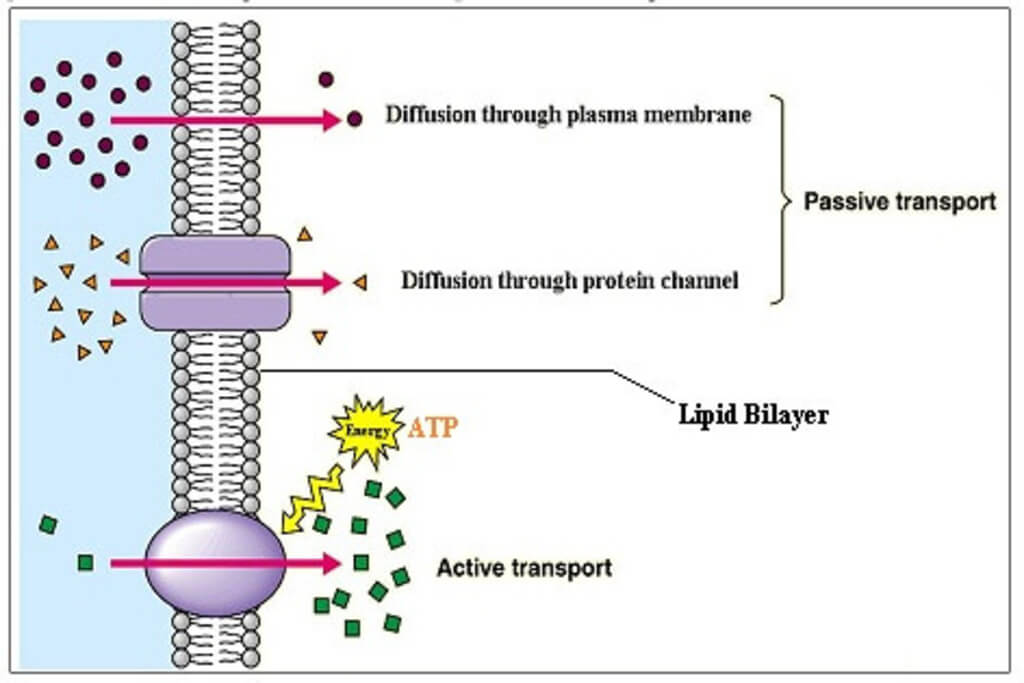
Active transport is a mode of transport wherein the transport requires energy because transport takes place against concentration gradient.
This mode of transport can be easily inhibited by metabolic poisons. This inhibition results into selective accumulation of drug on one side of membrane.
Many transport system take part in Active transport like Organic anion transporting polypeptide (OATP), Organic cation transporter (OCT), Neurotransmitter transporters for Nor-epinephrine, Serotonin and Dopamine (NET, SERT and DAT), etc.
Example: Levodopa and methyl dopa are actively transported from Aromatic amino acid transport system and many other transport systems like p-glycoprotein (p-gp) is also an example of active transport mechanism in Pharmacokinetics.
B) Facilitated diffusion:
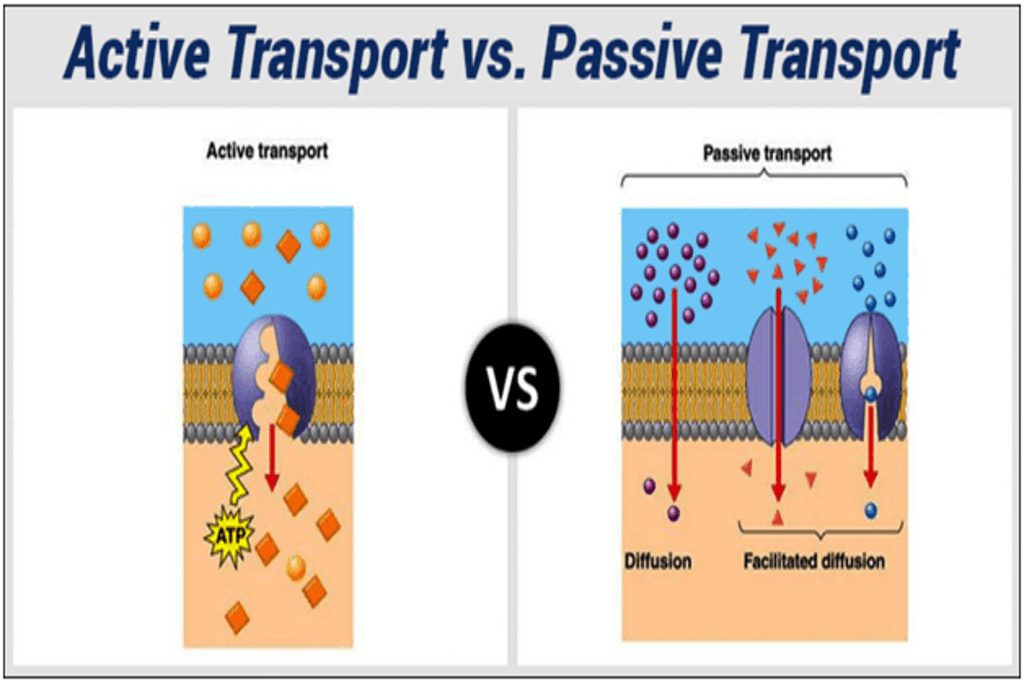
Facilitated transport is also known as Passive mediated transport.
This process does not need energy because it transports the drug on the basis of concentration gradient or electrochemical gradient.
This process is comparatively more fast and rapid than simple diffusion.
This transports even non-diffusible substrate across the membrane. This transport system belongs to super family of solute carrier(SLC) transporters.
Example: Glucose enters into muscle and fat cells by the glucose transporter GLUT 4.
2. Pinocytosis:
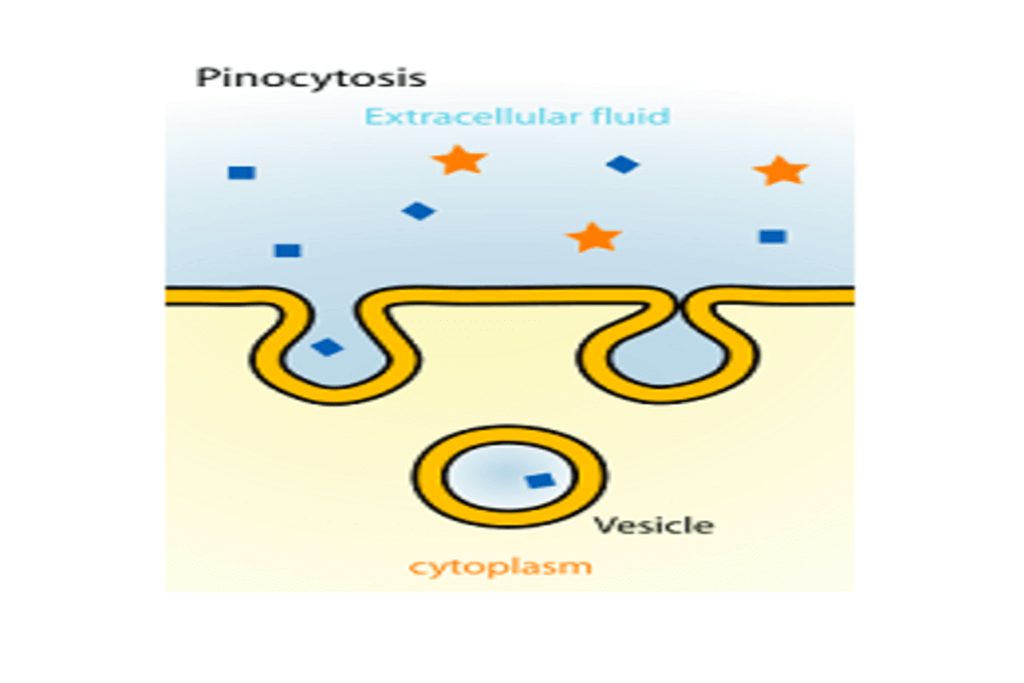
This is a process of transport where a drug attached to cell membrane is steadily engulfed by formation of vesicle around it.
It is taken into the cell cytoplasm and the vesicle disintegrates and drug is transported into the cell.
This mode is applicable to larger molecules like proteins, etc.
Difference between Simple diffusion and Facilitated diffusion
| Simple diffusion | Facilitated diffusion |
|---|---|
| 1. Simple diffusion is type of passive diffusion where the drug moves along the concentration gradient without any help of carrier. | 1. Facilitated diffusion is type of Carrier mediated transport where the drug moves along the concentration gradient but need carriers to transport. |
| 2. Occurs through Lipid bilayer. | 2. Occurs through trans-membrane protein. |
| 3. Transportation of small nonpolar molecules. | 3. Transportation of large polar molecule. |
| 4. Relatively fast. | 4. Relatively slow. |
| 5. Occurs through cell membrane. | 5. Occurs through facilitator proteins. |
| 6. Transport depends on concentration gradient and membrane permeability. | 6. Transport depends upon concentration gradient along with kinetics of protein. |
| Example: Diffusion of gas across the membrane. | Example: Sodium ions and glucose transport. |
Conclusion
Drugs in the body transports to various parts or various compartments of body, for that transport many transport system is required (Pharmacokinetics).
All this passage of drug requires, movement of drug from a plasma membrane that membrane is called as Biological membrane.
The lipid soluble drugs can easily transport from biological membrane as the membrane is lipoidal in nature but the aqueous soluble or water soluble drug cannot easily pass from that membrane, so some carriers are required for that transportation.
Also the drug travel along the concentration gradient that is from high concentration side to the low concentration side. If a drug has to travel against the concentration gradient the carrier mediated transport is required and for that energy is utilized. Energy is utilized in the form of ATP (Adenosine tri phosphate).
Passive diffusion does not require energy because it is a transport system where drug is transported along the concentration gradient. Passive diffusion, Filtration and Facilitated transport do not need energy but carrier mediated active transport needs energy for the transport.
That energy is also called as cellular energy.
Frequently Asked Questions (FAQs)
Factors affecting pharmacokinetics may be nature of drug, lipid solubility and water solubility of drug, particle size ,additives, genetic factors of patient, Disease state, Route of administration, Concentration of drug administered, food interactions, drug interactions, First pass metabolism affects pharmacokinetic behaviours of drug.
It includes everything related to what body does to the drug, Absorption, metabolism, distribution and excretion.
Pharmacokinetics help in drug designing as if the drugs get disintegrates in intestine rapidly the drug can be covered with gelatin that is known as enteric coated drugs. If the drugs gets severely affected by first pass metabolism and very small amount of drug reaches site of action then the prodrug can be administered, that prodrug is inactive state of active form, when it undergo first pass metabolism it gets converted to active form so more amount of drug reaches the site of action.
In children the dose of drug is very small as compared to adults because their Organ systems and renal system are not well developed. In elderly people somewhat same is the problem so pharmacokinetic properties varies age to age.
Simple difference is Pharmacokinetics is what the body does to the drug and Pharmacodynamics is what drug does to the body.
Grateful to Share My World with You.
